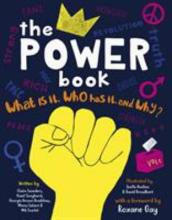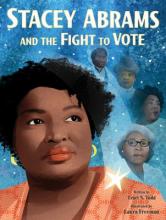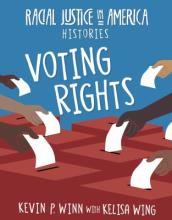With election season in full swing, it's an ideal opportunity to talk with kids about how voting works and why it matters. Discover our picks for books about the history of voting rights along with more library resources at www.denverlibrary.org/vote.

Life on the farm with Granddaddy is full of hard work, but despite all the chores, Granddaddy always makes time for play, especially fishing trips. Even when there isn't a bite to catch, he reminds young Michael that it takes patience to get what's coming to you. One morning, when Granddaddy heads into town in his fancy suit, Michael knows that something very special must be happening--and sure enough, everyone is lined up at town hall! For the very first time, Granddaddy is allowed to vote, and he couldn't be more proud. But can Michael be patient when justice just can't come soon enough?

A timely picture book that acts as an introduction to civics for young readers.

Sofia is put in charge of overseeing a fair election for a class pet, but first the Questioneers must learn about elections and good journalism--and remember that being a community matters most. Includes facts about the Delano Grape Strike, presidential elections, journalism, and the importance of voting.

Young Tansy is roused early and hurried through her morning routine on what Big Mama calls a "big day," then accompanies Big Mama as she becomes the first Black woman to cast her vote. Includes historical notes, timeline of the Woman's Suffrage Movement, and a biographical sketch of Agnes Sadler, the first Black woman to vote in Knoxville, Tennessee.

Who was at the forefront of women's right to vote? We know a few famous names, like Susan B. Anthony and Elizabeth Cady Stanton, but what about so many others from diverse backgrounds--black, Asian, Latinx, Native American, and more--who helped lead the fight for suffrage? On the hundredth anniversary of the historic win for women's rights, it's time to celebrate the names and stories of the women whose stories have yet to be told.

A powerful look at the evolution of voting rights in the United States, from our nation's founding to the present day.

The late 1950s was a turbulent time in Fayette County, Tennessee. Black and White children went to different schools. Jim Crow signs hung high. And while Black hands in Fayette were free to work in the nearby fields as sharecroppers, the same Black hands were barred from casting ballots in public elections. If they dared to vote, they faced threats of violence by the local Ku Klux Klan or White citizens. It wasn't until Black landowners organized registration drives to help Black citizens vote did change begin--but not without White farmers' attempts to prevent it. They violently evicted Black sharecroppers off their land, leaving families stranded and forced to live in tents. White shopkeepers blacklisted these families, refusing to sell them groceries, clothes, and other necessities. But the voiceless did finally speak, culminating in the Voting Rights Act of 1965, which legally ended voter discrimination.

Now more than ever, it's so important for everyone to understand our government: where it came from, how it works, and how we can bring about change. And, after all, in the words of author and government teacher Jeff Foster, "If you don't participate, you can't complain." This book is a comprehensive and entertaining guide that answers questions like: What is the Constitution? What are the branches of the government? What is the Electoral College? What are the political parties? What are the different responsibilities of the city, state, and federal governments? Plus, discover the complete backstory on some of our government's most important moments, like why we wrote the Declaration of Independence, and how people since then have worked with -- and protested against -- the government to improve the lives of all Americans

Profiles ten women who fought hard to gain the right to vote in the United States, including Elizabeth Cady Stanton, Susan B. Anthony, Sojourner Truth, and Inez Milholland.

The students of Stanton Elementary School, which is a polling place, find out all they can about voting and then encourage everyone in their neighborhoods to cast their ballots. Creative nonfiction picture book: includes additional facts and historical details.

Takes a look at different types of power, what it means to have power, and what you can do with your own power to create positive change in the world, no matter who or how old you are.

Paula Young Shelton shares her memories of the civil rights movement and her involvement in the historic march from Selma to Montgomery.

Stacey Abrams, politician and Nobel peace prize nominee, is brought to life in this poetic picture book biography that follows Abrams's fight for voters' rights. Narrated by Sojourner Truth, Ida B. Wells-Barnett, Septima Clark, and Fannie Lou Hamer, this powerful story tells how Abrams's work was inspired by those luminaries before her.

Demonstrating the power of protest and standing up for a just cause, here is an exciting tribute to the educators who participated in the 1965 Selma Teachers' March.

Presents a collage-illustrated treasury of poems and spirituals inspired by the life and work of civil rights advocate Fannie Lou Hamer.

The Racial Justice in America: Histories series explores moments and eras in America's history that have been ignored or misrepresented in education due to racial bias. Voting Rights explores the regulations Black people and people of color have endured in pursuit of their right to vote. Concepts are approached in a comprehensive, honest, and age-appropriate way. Developed in conjunction with educator, advocate, and author Kelisa Wing to reach children of all races and encourage them to approach our history with open eyes and minds. Books include 21st Century Skills and content, as well as activities created by Wing. Also includes a table of contents, glossary, index, author biography, sidebars, educational matter, and activities.

As an elderly woman, Lillian recalls that her great-great-grandparents were sold as slaves in front of a courthouse where only rich white men were allowed to vote, then the long fight that led to her right--and determination--to cast her ballot since the Voting Rights Act gave every American the right to vote.